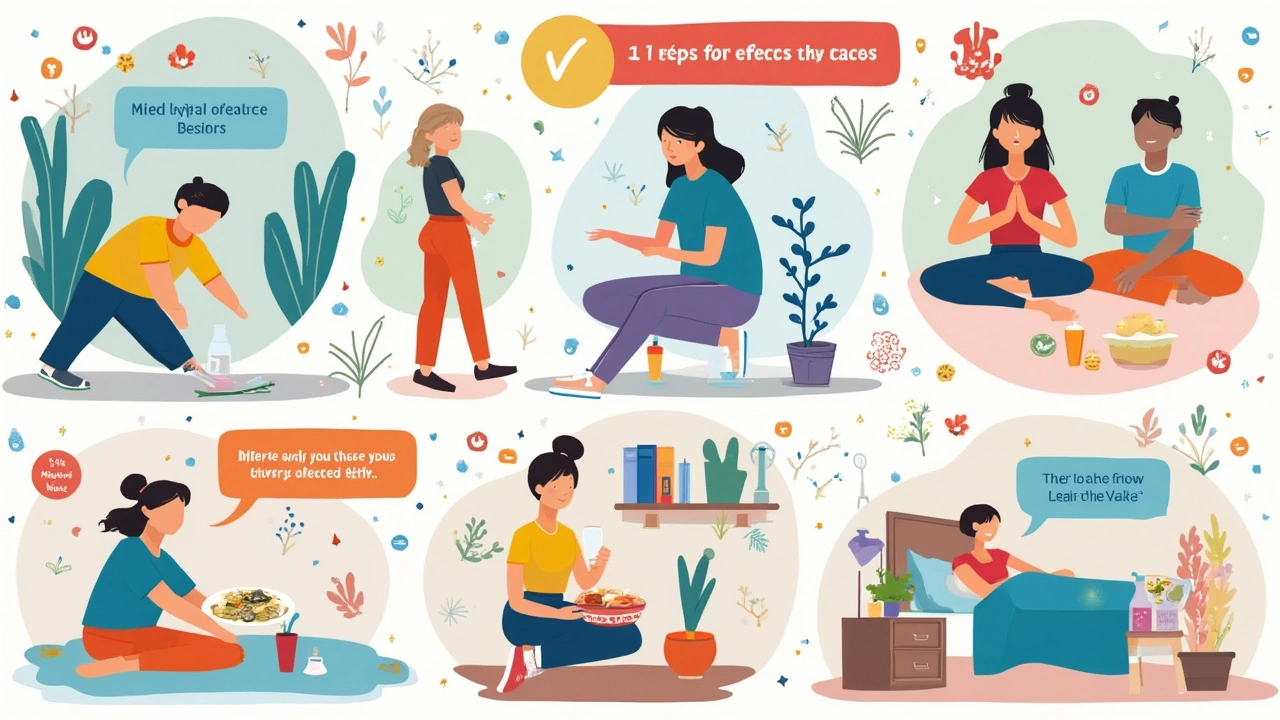Smart Diet and Lifestyle Habits to Lower Chronic Inflammation Naturally
 Apr, 26 2025
Apr, 26 2025
What Exactly Is Chronic Inflammation — And Why Does It Matter?
The word "inflammation" gets tossed around so much these days that it almost loses its punch. But behind the buzz, there’s something real happening in your body. When your immune system spots something shady—like an infection or injury—it sparks inflammation to help you heal. That’s good inflammation. Now, imagine never flipping that switch off: the repair crew keeps hammering away long after the damage is cleared. That’s chronic inflammation. It lingers quietly and, over months or years, it can wear out organs, mess with blood vessels, and even feed diseases like heart trouble, diabetes, arthritis, or even some cancers. Creepy, right? Research out of Harvard pinned chronic inflammation as a root cause for aging-related conditions. And here’s the worst part: you could have it and not even feel "sick" because the symptoms are so vague—think fatigue, headaches, stomach knots, or even random skin breakouts. If your lifestyle is even a little heavy on processed foods, high stress, and not enough sleep, you’re pretty much throwing fuel on the fire. Medical experts often talk about fancy biomarkers—like CRP or interleukin-6—that show spikes when inflammation is simmering inside. But it isn’t just numbers in a blood test. It’s how you eat, move, think, and rest every single day that actively sculpts your risk. Don’t freak out—control is in your hands. What you put in your mouth, your stress load, and how you sleep create the foundation. Let’s break down how regular people (not just folks in lab coats) use this info to dodge the dangers and live stronger.
Building an Anti-Inflammatory Plate: Food Choices With Real Payoff
You don’t need to overhaul everything in your fridge or swear off flavor to eat in a way that cools inflammation. The easiest road to success follows a "whole foods, plant-forward" path. Basically, the more your food looks like it grew or swam, the better. The Mediterranean diet is the heavy hitter here, proven by studies from Spain to America to drop markers of inflammation like CRP (C-reactive protein) and lower risk of nasty stuff like heart disease. This style leans on colorful veggies and fruits—think tomatoes, leafy greens, peppers, and berries—plus olive oil, nuts, seeds, beans, fish, and whole grains. Red wine? Sure, if you drink it sensibly; resveratrol in the grape skin has been flagged for calming inflammation.)
But it’s not just about what you add. Subtracting really matters. Limit sugary sodas, pastries, and anything with "hydrogenated" fats. Heavily processed meats like bacon and sausage, fried fast foods loaded with seed oils or trans fats, and the all-around overconsumption of refined carbs drive inflammation higher. Swap processed lunch meats for salmon or lentil soup. Reach for walnuts or a few squares of dark chocolate instead of a packaged candy bar. Tinned sardines come packed with omega-3s, which slow the wheels turning on inflammation—far from Grandma’s medicine.
If you’re looking for superstars, aim for:
- Leafy greens: Spinach, kale, and arugula pack vitamins, antioxidants, and magnesium.
- Berries: Strawberries, blueberries, blackberries—just a handful can make a dent in daily inflammation.
- Fatty fish: Salmon, mackerel, sardines and tuna. Two servings per week is the sweet spot, based on clinical trials.
- Spices: Turmeric (with a pinch of black pepper to boost absorption), ginger, and garlic aren’t just flavor boosters—they contain compounds shown in studies to block inflammatory pathways.
- Extra-virgin olive oil: Acts as a foundation for salads, dips, or low-heat cooking. Some research puts it on par with ibuprofen for inflammation-blunting effects due to its polyphenols.
- Nuts: Particularly walnuts, almonds, and pistachios.
And don’t forget fiber. The link between fiber and lower inflammation is one of the most boring, under-hyped facts in health. Fiber feeds your gut bacteria, and when your gut is happy, your inflammation stays chill. Aim for 25 (women) to 38 (men) grams per day. An easy fix? Overnight oats with blueberries and a sprinkle of flaxseed gets you a third of the way there before lunchtime.
Some folks wonder about supplements—fish oil, for example. The catch is, results can be all over the place. Talk to your doctor, especially if you’re mixing these with medicines, because it’s not always a simple swap. Speaking of safer swaps, if you want more details about alternatives to dexamethasone medication that help with inflammation, that guide is stacked with up-to-date perspectives and is way easier to understand than most medical pamphlets.

Busting Stress: Practical Ways to Calm the Inner Storm
If you’ve never lost your cool with a passive-aggressive email late at night, you’re superhuman. Stress piles on inflammation in no time. Just look at research from a team at Carnegie Mellon showing that mental stress spikes pro-inflammatory cytokines—the signaling molecules that whisper "trouble brewing" to your immune system. But here’s the kicker: This isn’t just a mind-body "woo-woo" idea. Even short, daily mindfulness exercises have been shown in randomized controlled trials to lower these markers in healthy people and patients alike.
So, how do regular folks knock down chronic stress without adopting a monk’s routine? Start basic—use the five-minute rule. Five minutes of daily deep breathing (inhale for four, exhale for six, repeat) can actually trim cortisol levels. That’s the hormone that keeps your body in fight-or-flight mode long after the saber-toothed tiger is gone. If guided meditation isn’t your thing, walk outside for ten minutes with no phone, or zone out to music—just let your brain hit "pause." When I feel the pressure (hello, screaming deadlines), even something as small as squeezing a stress ball or tidying my desk resets my mood. For my wife, Fiona, it’s gardening—getting her hands in the dirt and nurturing a patch of basil. Go with what feels natural.
Move—even a little—each day. You don’t need an army of gym influencers cheering you on. Simple stuff, like walking briskly, biking, or a home yoga session, all cut inflammation. A study from Stanford showed subjects who walked 20 minutes saw a direct drop in levels of TNF-alpha, another key marker for chronic inflammation. Aim for 150 minutes per week (that’s three 50-minute walks) and you’re golden. Social connection matters, too. People who nurture their friendships and close relationships consistently have lower inflammatory markers—even accounting for stuff like diet and sleep. So grab coffee with a buddy, call your sibling, or join a trivia team. Laughter itself triggers calming chemicals—so if you need permission to binge cat videos, science says you’re doing your body a favor!
And then there’s the magic of boundaries. Take breaks from the doom-scroll rabbit hole of news and social media when you can. Even a small digital detox (avoiding screens for the first 30 minutes after waking up) is surprisingly powerful for slowing the stress response, according to a survey on digital habits at the University of Pennsylvania.
Sleep Hygiene: Resetting Inflammation Overnight
Ever pull an all-nighter or get by on five hours for a week? Your immune system gets confused; it’s almost like you caught a mild infection. Data from the University of California tracked sleep-deprived adults and found their inflammatory markers shot up by 30%. That’s massive. Good sleep lessens inflammation—bad sleep sends it rocketing north. But here’s the twist: it isn’t just about logging more hours. You need quality Z’s.
Here are some habits that work (and don’t require weird gadgets or sleep consultants):
- Stick to a schedule. Going to bed and waking at the same time—even weekends—makes a difference, because your circadian rhythm controls the release of inflammatory molecules.
- Ban screens for 30-60 minutes before sleep. Blue light blocks melatonin, your "sleep hormone.”
- Keep your room cool and dark—invest in blackout curtains if streetlights peer in, and drop the thermostat to about 65 degrees Fahrenheit (18°C).
- Cut caffeine after two o’clock. Sounds minor, but caffeine is sneaky. It’ll hang around in your bloodstream for up to eight hours and wink at your nerve endings when you wish it wouldn’t.
- Limit late-night heavy meals and alcohol. Both disrupt deep sleep cycles, which are needed for immune system repair.
- If you wake up in the middle of the night, don’t grab your phone. Try a breathing exercise—like four-count square breathing—or keep a notepad by your bed for racing thoughts.
If you’re a snorer, or your partner (Fiona, in my case) points out that you sometimes stop breathing at night, get checked for sleep apnea. This sleep disorder ramps up the risk of high inflammation. Catching lapses in breathing early is worth its weight in gold. And don’t chase perfection; a few rough nights won’t doom your immune system. Small changes add up—and science says improving average sleep, even slightly, pays off across the whole body.

Daily Tweaks for Long-Term Success
Nobody flips a switch and goes from inflamed to Zen overnight. But small actions, stacked together, matter more than big promises. It’s consistency, not the pursuit of a mythical “perfect” diet or life, that carves results into your biology. Try starting with any one of these:
- Add one veggie to your lunch every day for a week. Rotate cucumbers, carrots, or grilled red peppers.
- Switch your refined grains—think white rice, white bread—for their whole grain cousins. Even microwavable brown rice counts.
- If you need a snack, go for nuts or seeds. A small handful stops hunger and is loaded with natural anti-inflammatories.
- Take the stairs over the elevator once a day. Even short bursts of movement lower inflammation markers.
- Do a five-minute stretch or gratitude journaling session before bed instead of scrolling your phone.
Find foods and activities you enjoy—no one sticks with boring rules. And if you slip? That’s reality. What counts is coming back the next meal, next day, or next week. Surround yourself with people who support your changes; it could be family, friends, or even online communities. If you’re ever confused about which inflammation-fighting approaches are right for you, consulting with a dietitian, a sleep coach, or a therapist isn’t a sign of weakness—it’s like using a GPS the first few drives somewhere new.
New studies emerge all the time, but the basics stay the same: eat real food, move your body, reduce avoidable stress, and make sleep non-negotiable. Your body is built to heal—just give it the right fuel, rest, and rhythms, and inflammation doesn’t stand a chance.

Mary Akerstrom
April 30, 2025 AT 01:30I really appreciate how you laid out the science behind chronic inflammation without drowning us in jargon. The practical tips on food and stress are easy to start with, and they feel doable for anyone with a busy schedule. Adding a handful of berries or a quick walk can make a noticeable difference over time. Keep sharing these kind of balanced guides, they help a lot of us feel less overwhelmed.
Delilah Allen
May 4, 2025 AT 19:57Honestly, the whole "just eat more veggies" mantra feels like a lazy excuse, especially when the food industry floods us with processed junk, cheap sugars, and hidden trans fats, which are engineered to keep us hooked, and the stress epidemic is a manufactured crisis, designed to keep us in perpetual anxiety, and the sleep hacks you mention are just band‑aid solutions for a system that profits from our exhaustion!
Nancy Lee Bush
May 9, 2025 AT 14:25Wow, such a thorough breakdown! I love how you highlighted turmeric and ginger-those spices are real game‑changers, and the suggestion to add a daily five‑minute breathing exercise is both simple and powerful, plus the focus on gut‑friendly fiber really ties everything together :)
Dan Worona
May 14, 2025 AT 08:53Sure, you can sprinkle some turmeric on your kale, but have you ever considered that the “studies” praising these foods are funded by big pharma and agribusinesses looking to push their supplement sales? The whole anti‑inflammation narrative conveniently distracts us from the real agenda-surveillance through wearables that track your sleep, diet, and stress levels so corporations can monetize your health data. Wake up, folks, the cure is a conspiracy.
Chuck Bradshaw
May 19, 2025 AT 03:21While the enthusiasm is commendable, the evidence is more nuanced. Meta‑analyses show that omega‑3 supplementation reduces CRP modestly, but the effect size varies widely depending on baseline diet, genetics, and compliance. It's also crucial to differentiate between whole‑food sources-like sardines-and isolated fish‑oil capsules, which may have different bioavailability. Overstating benefits can mislead readers into thinking supplements alone will solve chronic inflammation.
Howard Mcintosh
May 23, 2025 AT 21:48Yo, just start small-add a banana to ur breakfast or take the stairs 1 extra time. It’s def easier than overhaulin a whole diet. You’ll feel the boost quick, trust me.
Jeremy Laporte
May 28, 2025 AT 16:16Great post! I think the key is to keep things realistic-swap one refined grain for a whole‑grain option each week, and share a quick veggie side with friends. Small wins add up, and the community support makes it fun.
Andy Lombardozzi
June 2, 2025 AT 10:44Precise recommendation: incorporate 30 g of mixed nuts daily, ensure at least 150 minutes of moderate aerobic activity per week, and maintain a consistent sleep schedule with a bedtime variance of no more than 30 minutes.
Joshua Ardoin
June 7, 2025 AT 05:11Love the balanced vibe here 🌈-it’s like a kaleidoscope of health tips that everyone can sparkle with! Adding a splash of humor and a dash of emojis keeps the convo lively and inclusive. 👍🌱
Glenn Gould
June 11, 2025 AT 23:39Just start moving, it works.
Poonam Sharma
June 16, 2025 AT 18:07It’s outrageous how Western media refuses to acknowledge the ancient Ayurvedic wisdom that our ancestors used to combat inflammation, while they shove us endless sugar‑laden snacks and glorify fast food-this cultural genocide is a direct attack on our national health sovereignty, and we must resist the neocolonial diet agenda now!
Meigan Chiu
June 21, 2025 AT 12:34While the article is generally solid, it glosses over the fact that not all “anti‑inflammatory” foods have the same effect across different genotypes; a more rigorous citation of randomized controlled trials would strengthen the argument. Furthermore, watch out for dangling modifiers and ensure consistent Oxford commas for clarity.
Patricia Hicks
June 26, 2025 AT 07:02Reading through this guide feels like taking a refreshing walk through a garden of wellness, where each tip is a blooming flower offering its unique fragrance. First, the emphasis on whole, plant‑forward foods reminds us that nature’s palette is already designed to heal, and opting for colorful vegetables is both visually appealing and nutritionally potent. Second, the inclusion of omega‑3‑rich fish adds a marine dimension, illustrating how the ocean’s bounty complements the land’s produce. Third, the practical suggestion of five‑minute breathing exercises fits neatly into even the busiest of schedules, proving that mindfulness doesn’t require a retreat. Fourth, the sleep hygiene checklist is a masterclass in simplicity-consistent bedtime, cool dark room, and screen curfew are the pillars of restorative rest. Fifth, the encouragement to replace refined carbs with whole grains acknowledges the gut‑brain axis, highlighting the importance of fiber for a thriving microbiome. Sixth, the advice to cultivate social connections underscores that emotional health is intertwined with physical inflammation. Seventh, the reminder to set boundaries with digital media is a timely note in our hyper‑connected era. Eighth, the recipe ideas, like overnight oats with berries and flaxseed, demonstrate that deliciousness and health can coexist. Ninth, the call to celebrate small victories keeps motivation high, reminding us that progress is cumulative. Tenth, the suggestion to seek professional guidance when needed normalizes the role of experts, reducing stigma around health coaching. Eleventh, the narrative style is approachable, making complex science digestible without sacrificing accuracy. Twelfth, the balanced tone avoids fear‑mongering, instead empowering readers to take actionable steps. Thirteenth, the acknowledgement that slip‑ups happen fosters a growth mindset. Fourteenth, the overall structure-breaking down diet, stress, sleep, and daily tweaks-offers a comprehensive roadmap. Finally, this piece serves as a reminder that we possess the tools to modulate inflammation, and with consistency, we can sculpt a healthier, more resilient self.
Quiana Huff
July 1, 2025 AT 01:30Let’s turbo‑charge these habits: integrate intermittent fasting protocols, leverage high‑intensity interval training for rapid cytokine reduction, and use adaptogenic herbs like ashwagandha to buffer cortisol spikes. The synergy of these evidence‑backed strategies can amplify anti‑inflammatory outcomes. 🚀💪